SMPTE STANDARD
SMPTE ST 2081-11:2016
2160-line Source Image
and Ancillary Data Mapping
for Dual-link 6G-SDI
Page 1 of 20 pages
Page
Table of Contents
Foreword ................................................................................................................................................. 2
Intellectual Property ................................................................................................................................ 2
Introduction.............................................................................................................................................. 2
1 Scope ................................................................................................................................................. 4
2 Conformance Notation ....................................................................................................................... 4
3 Normative References ....................................................................................................................... 4
4 Mode 1: Carriage of 2160-line Source Image Formats and Ancillary Data ....................................... 5
4.1 Mapping ..................................................................................................................................... 6
4.2 Audio Data ................................................................................................................................. 11
4.3 Payload Identifier ....................................................................................................................... 13
4.4 Blanking (Informative) ................................................................................................................ 15
4.5 Multiplex ..................................................................................................................................... 16
4.6 Levels of Operation (Informative) ............................................................................................... 16
5 Dual-link 6G-SDI 10-bit Multiplex ....................................................................................................... 16
6 6G-SDI Link 1 / 6G-SDI Link 2 Interface Timing ................................................................................ 18
Annex A Ancillary Data Capacity of the Dual-link 6G-SDI Interface (Informative) ............................... 19
Annex B Bibliography (Informative) ..................................................................................................... 20
Copyright © 2016 by THE SOCIETY OF
MOTION PICTURE AND TELEVISION ENGINEERS
3 Barker Avenue, White Plains, NY 10601
(914) 761-1100
Approved
June 15, 2016
�
SMPTE ST 2081-11: 2016
Foreword
SMPTE (the Society of Motion Picture and Television Engineers) is an internationally-recognized standards
developing organization. Headquartered and incorporated in the United States of America, SMPTE has
members in over 80 countries on six continents. SMPTE’s Engineering Documents, including Standards,
Recommended Practices, and Engineering Guidelines, are prepared by SMPTE’s Technology Committees.
Participation in these Committees is open to all with a bona fide interest in their work. SMPTE cooperates
closely with other standards-developing organizations, including ISO, IEC and ITU.
SMPTE Engineering Documents are drafted in accordance with the rules given in its Standards Operations
Manual.
SMPTE ST 2081-11 was prepared by Technology Committee 32NF.
Intellectual Property
At the time of publication no notice had been received by SMPTE claiming patent rights essential to
the implementation of this Engineering Document. However, attention is drawn to the possibility that some
of the elements of this document may be the subject of patent rights. SMPTE shall not be held responsible
for identifying any or all such patent rights.
Introduction
SMPTE ST 2081-11 defines the mapping of various source images and associated ancillary data into a Dual-
link 6 Gb/s [nominal] SDI bit-serial interface.
The general process for creating a dual-link 6G-SDI is illustrated below in Figure 1. Detailed definitions of how
this process applies to each of the modes defined in the scope follow in other sections of this document.
Source
Image data
Division to Sub
Images
Mapping onto 80-bit
Virtual Interface
Dual 6G-SDI 10-bit
Multiplex
2160-line
Image
Sub Image One
Sub Image Two
Sub Image Three
Sub Image Four
Data Stream
One
Data Stream
Two
Data Stream
Three
Data Stream
Four
Data Stream
Five
Data Stream
Six
Data Stream
Seven
Data Stream
Eight
Mux
6G-SDI 10-bit
interface ST 2081-1
Link One
Mux
6G-SDI 10-bit
interface ST 2081-1
Link Two
Figure 1 – Carriage of 2160-line images in a Dual-link 6G-SDI interface – generalized process
Page 2 of 20 pages
Authorized licensed use limited to: Stanford University. Downloaded on November 10,2017 at 07:27:33 UTC from IEEE Xplore. Restrictions apply.
�
SMPTE ST 2081-11:2016
Formatting
The source images are divided into four 1080-line sub images.
The sub images are then mapped onto an 80-bit virtual interface consisting of eight 10-bit data streams. Each
10-bit data stream includes timing and sync words, line numbers, cyclic redundancy codes, ancillary data,
including audio, and payload identification packets.
Multiplex
The 80-bit virtual interface is multiplexed onto two 6G-SDI 10-bit interfaces. The first four data streams are
multiplexed in the order data stream four, data stream two, data stream three, data stream one…onto 6G-SDI
Link 1. The second four data streams are multiplexed in the order data stream eight, data stream six, data
stream seven, data stream five…onto 6G-SDI Link 2.
Authorized licensed use limited to: Stanford University. Downloaded on November 10,2017 at 07:27:33 UTC from IEEE Xplore. Restrictions apply.
Page 3 of 20 pages
�
SMPTE ST 2081-11: 2016
1 Scope
This standard defines the mapping of:
Mode 1: 2160-line Source image formats and ancillary data into a Dual-link 6 Gb/s [nominal] SDI bit-
serial interface
This standard also defines the carriage of the SMPTE ST 352 payload ID’s for the Dual-link 6Gb/s SDI
interface.
It is not necessary for implementations to include support for all formats that are included in this ST.
Implementers should indicate supported formats in commercial publications.
2 Conformance Notation
Normative text is text that describes elements of the design that are indispensable or contains the
conformance language keywords: "shall", "should", or "may". Informative text is text that is potentially helpful
to the user, but not indispensable, and can be removed, changed, or added editorially without affecting
interoperability. Informative text does not contain any conformance keywords.
All text in this document is, by default, normative, except: the Introduction, any section explicitly labeled as
"Informative" or individual paragraphs that start with "Note:”
The keywords "shall" and "shall not" indicate requirements strictly to be followed in order to conform to the
document and from which no deviation is permitted.
The keywords, "should" and "should not" indicate that, among several possibilities, one is recommended as
particularly suitable, without mentioning or excluding others; or that a certain course of action is preferred but
not necessarily required; or that (in the negative form) a certain possibility or course of action is deprecated
but not prohibited.
The keywords "may" and "need not" indicate courses of action permissible within the limits of the document.
The keyword “reserved” indicates a provision that is not defined at this time, shall not be used, and may be
defined in the future. The keyword “forbidden” indicates “reserved” and in addition indicates that the provision
will never be defined in the future.
A conformant implementation according to this document is one that includes all mandatory provisions
("shall") and,
if implemented, all recommended provisions ("should") as described. A conformant
implementation need not implement optional provisions ("may") and need not implement them as described.
Unless otherwise specified, the order of precedence of the types of normative information in this document
shall be as follows: Normative prose shall be the authoritative definition; Tables shall be next; followed by
formal languages; then figures; and then any other language forms.
3 Normative References
The following standards contain provisions that, through reference in this text, constitute provisions of this
standard. At the time of publication, the editions indicated were valid. All standards are subject to revision,
and parties to agreements based on this standard are encouraged to investigate the possibility of applying the
most recent edition of the standards indicated below.
SMPTE ST 299-1:2009, 24-Bit Digital Audio Format for SMPTE 292 Bit-Serial Interface
SMPTE ST 299-2:2010, Extension of the 24-Bit Digital Audio Format to 32 Channels for 3 Gb/s Bit-Serial
Interfaces
SMPTE ST 352:2013, Payload Identification Codes for Serial Digital Interfaces
Page 4 of 20 pages
Authorized licensed use limited to: Stanford University. Downloaded on November 10,2017 at 07:27:33 UTC from IEEE Xplore. Restrictions apply.
�
SMPTE ST 2081-11:2016
SMPTE ST 425-5:2015, Image Format and Ancillary Data Mapping for the Quad Link 3 Gb/s Serial Interface
SMPTE ST 2048-1:2011, 2048 × 1080 and 4096 × 2160 Digital Cinematography Production Image Formats
FS/709
Amendment 1:2016 to SMPTE ST 2048-1:2011
4 Mode 1: Carriage of 2160-line Source Image Formats and Ancillary Data
In the case of 2160-line mapping, the image formats supported are defined in SMPTE ST 425-5, Table 1 –
2160-line Source Image Formats, repeated here for convenience.
Table 1 – 2160-line Source Image Formats Supported (Informative)
Reference
SMPTE
Standard
Image Format
ST 2036-1
3840 2160
Signal Format Sampling
Structure/pixel Depth
4:2:2 (Y′C′BC′R),
4:2:0 (Y′C′BC′R)/10-bit
ST 2048-1
4096 2160*2
4:2:2 (Y′C′BC′R)/10-bit
Frame Rate
Hz
50, 60/1.001 and 60
Progressive
48/1.001, 48, 50,
60/1.001 and 60
Progressive
ST 2036-1
3840 2160
ST 2048-1
4096 2160*2
ST 2036-1
3840 2160
ST 2048-1
4096 2160*2
ST 2036-1
ST 2048-1
ST 2036-1
ST 2048-1
3840 2160
4096 2160*2
3840 2160
4096 2160*2
ST 2036-1
3840 2160
ST 2048-1
ST 2048-1
4096 2160*2
4096 2160*2
4:4:4 (R′G′B′)
4:4:4 (R′G′B′*1),
4:4:4:4 (R′G′B′*1+A)/10-bit
4:4:4 (Y′C′BC′R)
4:4:4 (Y′C′BC′R),
4:4:4:4 (Y′C′BC′R+A)/10-bit
4:4:4 (R′G′B′)/12-bit
4:4:4 (R′G′B′*1)/12-bit
4:4:4 (Y′C′BC′R)/12-bit
4:4:4 (Y′C′BC′R)/12-bit
4:2:2 (Y′C′BC′R)/12-bit
4:2:0 (Y′C′BC′R)/12-bit
4:2:2 (Y′C′BC′R)/12-bit
4:2:2:4 (Y′C′BC′R+A)/12-bit
24/1.001, 24, 25,
30/1.001 and 30
Progressive
Notes:
*1
*2
In this image format R′G′B′ indicates either R′G′B′ or R′FSG′FSB′FS. An additional Color VANC packet to
describe the FS characteristics is defined by SMPTE ST 2048-1.
This is the maximum pixel array, the active image may not fill the maximum array.
Authorized licensed use limited to: Stanford University. Downloaded on November 10,2017 at 07:27:33 UTC from IEEE Xplore. Restrictions apply.
Page 5 of 20 pages
�
SMPTE ST 2081-11: 2016
4.1 Mapping
The source image shall be divided into four sub-images in accordance with the 2-sample interleave division
method defined in SMPTE ST 425-5, Section 5.2.1, 2160-line Image Division into Four Sub Images.
The four resulting sub-images shall then be mapped into an 80-bit virtual interface in accordance with the sub
image mapping structure numeral 1, 2, 3 or 4 defined in SMPTE ST 425-5, Table 2 – 2160-line Source Image
Formats, such that:
Sub image 1 is mapped into data stream one and data stream two.
Sub image 2 is mapped into data stream three and data stream four.
Sub image 3 is mapped into data stream five and data stream six.
Sub image 4 is mapped into data stream seven and data stream eight
This process is illustrated in SMPTE ST 425-5, Figure 2 – Mapping Overview for 2160-line Source Images.
The 80-bit virtual interface shall include sync and timing (TRS) words, Cyclic redundancy code (CRC) words,
line numbers, HANC and VANC data and time code — except audio — according to SMPTE ST 425-5,
Section 6, Level A Mapping for 2160-line Source Images.
Informative Annex A provides information about the amount of HANC and VANC data space available in this
operating mode.
4.1.1 Mapping Process (Informative)
Figure 2 illustrates the process for the carriage of SMPTE ST 2036-1 and SMPTE ST 2048-1 2160-line
source image formats in a Dual-link 6G-SDI interface.
Source Image
2 sample interleave Sub-
division
80-bit Virtual Interface
Mapping
Dual 6G-SDI 10-bit
Multiplex
0
0
1
3
1
3
21
43
21
43
2 1
4 3
2 1
4 3
21
43
21
43
2
4
2
4
1
3
21
43
2 1
4 3
21
43
2
4
2159
1920/
2048
1
42
0
V
A
E
HANC
Data
V
A
S
1919/
2047
Sub Image 1
Data Stream One
Data Stream Two
1122
1125
3839/
4095
V
A
E
HANC
Data
V
A
S
V
A
E
HANC
Data
V
A
S
V
A
E
HANC
Data
V
A
S
Sub Image 2
Data Stream Three
Data Stream Four
Sub Image 3
Data Stream Five
Data Stream
Six
Sub Image 4
Data Stream Seven
Data Stream Eight
Mux
6G-SDI 10-bit
interface ST 2081-1
Link One
Mux
6G-SDI 10-bit
interface ST 2081-1
Link Two
Figure 2 – Carriage of 2160-line mapping source image formats in a dual-link 6G-SDI interface
Page 6 of 20 pages
Authorized licensed use limited to: Stanford University. Downloaded on November 10,2017 at 07:27:33 UTC from IEEE Xplore. Restrictions apply.
�
SMPTE ST 2081-11:2016
The 2160-line source image is divided into four 1080-line sub images in accordance with the 2 sample
interleave sub-division method referenced in SMPTE ST 425-5 2160-line Mapping.
For a 4:2:0 source image, the C′B and C′R samples in sub images 3 and 4 are set to the value 200h for 10-bit
systems and 800h for 12-bit systems.
Each 1080-line sub image has the structure as shown in SMPTE ST 425-5, Table 2 – Sub Image Formats,
repeated here for convenience in Table 2.
Table 2 – Sub Image Formats (Informative)
Source Image
Sub Image
Reference
SMPTE Standard
ST 2036-1
ST 2048-1
Image Format
3840 2160
4096 2160
Reference
SMPTE Standard
ST 274
ST 2048-2
Image Format
1920 1080
2048 1080
Each sub image is mapped into two 10-bit data streams.
Sub image 1 is mapped into data streams one and two.
Sub image 2 is mapped into data streams three and four.
Sub image 3 is mapped into data streams five and six.
Sub image 4 is mapped into data streams seven and eight.
Each data stream includes sync and timing (TRS) words, Cyclic redundancy code (CRC) words, line numbers,
HANC and VANC data and time code.
The eight 10-bit data streams are combined onto an 80-bit virtual interface:
4.1.2 2160-line 80-bit Virtual Interface Multiplex Structure (Informative)
The video data words from each sub image are conveyed in the following order in the data streams of the 80-
bit virtual interface:
Mapping Structure 1:
Sub image 1 is mapped into data streams one and two:
data stream one: Y′0, Y′1, Y′2, Y′3...
data stream two: C′B0, C′R0, C′B1, C′R1...
Sub image 2 is mapped into data streams three and four:
data stream three: Y′0, Y′1, Y′2, Y′3...
data stream four: C′B0, C′R0, C′B1, C′R1...
Sub image 3 is mapped into data streams five and six:
data stream five: Y′0, Y′1, Y′2, Y′3...
data stream six: C′B0, C′R0, C′B1, C′R1...
Sub image 4 is mapped into data streams seven and eight:
data stream seven: Y′0, Y′1, Y′2, Y′3...
data stream eight: C′B0, C′R0, C′B1, C′R1...
For a 4:2:0 source images, the 10-bit C′B and C′R samples in sub images 3 and 4 are set to the value 200h.
Authorized licensed use limited to: Stanford University. Downloaded on November 10,2017 at 07:27:33 UTC from IEEE Xplore. Restrictions apply.
Page 7 of 20 pages
�
SMPTE ST 2081-11: 2016
Mapping Structure 2:
Sub image 1 is mapped into data streams one and two:
data stream one: G′0, R′0, G′1, R′1...
data stream two: A0, B′0, A1, B′1...
Sub image 2 is mapped into data streams three and four:
data stream three: G′0, R′0, G′1, R′1...
data stream four: A0, B′0, A1, B′1...
Sub image 3 is mapped into data streams five and six:
data stream five: G′0, R′0, G′1, R′1...
data stream six: A0, B′0, A1, B′1...
Sub image 4 is mapped into data streams seven and eight:
data stream seven: G′0, R′0, G′1, R′1...
data stream eight: A0, B′0, A1, B′1...
Mapping Structure 3:
Bit b9 in every word is the complement of b8. The lists and tables below describe Bits b8 – b0
Sub image 1 is mapped into data streams one and two:
data stream one: R′G′B′ 0 [11:9], R′G′B′ 0 [5:3], R′G′B′ 1 [11:9], R′G′B′ 1 [5:3]...
data stream two: R′G′B′ 0 [8:6], R′G′B′ 0 [2:0], R′G′B′ 1 [8:6], R′G′B′ 1 [2:0]...
Sub image 2 is mapped into data streams three and four:
data stream three: R′G′B′ 0 [11:9], R′G′B′ 0 [5:3], R′G′B′ 1 [11:9], R′G′B′ 1 [5:3]...
data stream four: R′G′B′ 0 [8:6], R′G′B′ 0 [2:0], R′G′B′ 1 [8:6], R′G′B′ 1 [2:0]...
Sub image 3 is mapped into data streams five and six:
data stream five: R′G′B′ 0 [11:9], R′G′B′ 0 [5:3], R′G′B′ 1 [11:9], R′G′B′ 1 [5:3]...
data stream six: R′G′B′ 0 [8:6], R′G′B′ 0 [2:0], R′G′B′ 1 [8:6], R′G′B′ 1 [2:0]...
Sub image 4 is mapped into data streams seven and eight:
data stream seven: R′G′B′ 0 [11:9], R′G′B′ 0 [5:3], R′G′B′ 1 [11:9], R′G′B′ 1 [5:3]...
data stream eight: R′G′B′ 0 [8:6], R′G′B′ 0 [2:0], R′G′B′ 1 [8:6], R′G′B′ 1 [2:0]...
Mapping Structure 4:
Bit b9 in every word is the complement of b8. The lists and tables below describe Bits b8 – b0
Sub image 1 is mapped into data streams one and two:
data stream one: Bits b8 – b6: A0 [11:9],
Bits b5 – b0: Y′0 [11:6],
data stream two: Bits b8 – b6: A0 [8:6],
A0 [5:3],
Y′0 [5:0],
A1 [11:9],
Y′1 [11:6],
A1 [5:3]...
Y′1 [5:0]...
A0 [2:0],
A1 [8:6],
A1 [2:0]...
Bits b5 – b0: C′B 0 [11:6], C′B 0 [5:0], C′R 0 [11:6], C′R 0 [5:0]...
Page 8 of 20 pages
Authorized licensed use limited to: Stanford University. Downloaded on November 10,2017 at 07:27:33 UTC from IEEE Xplore. Restrictions apply.
�
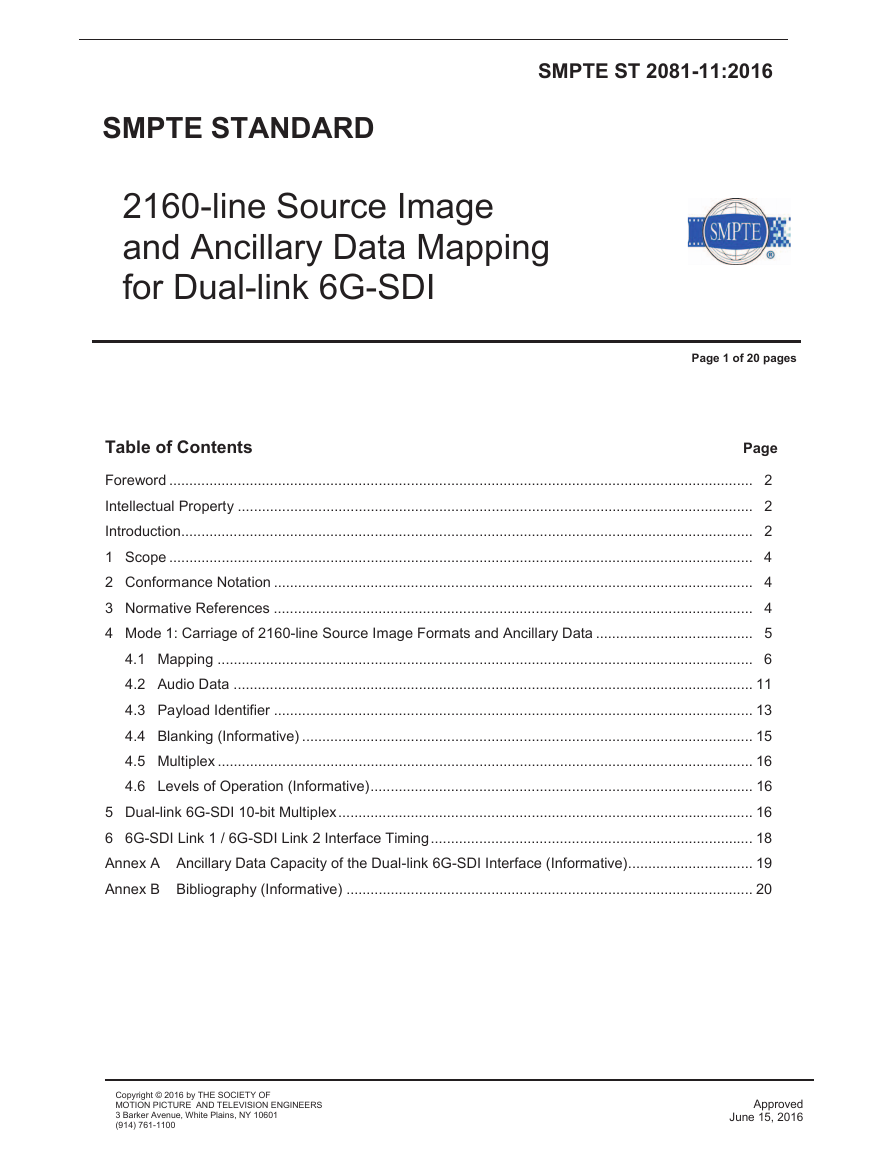
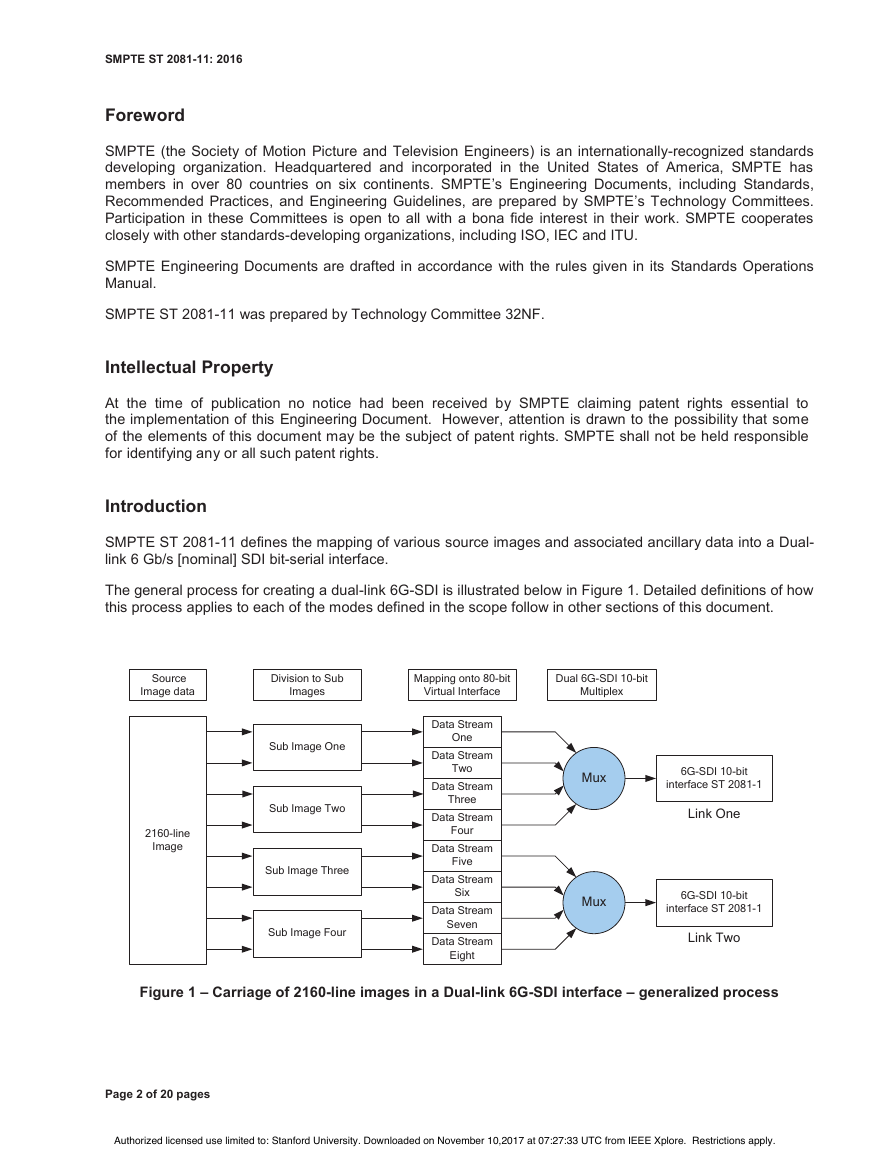
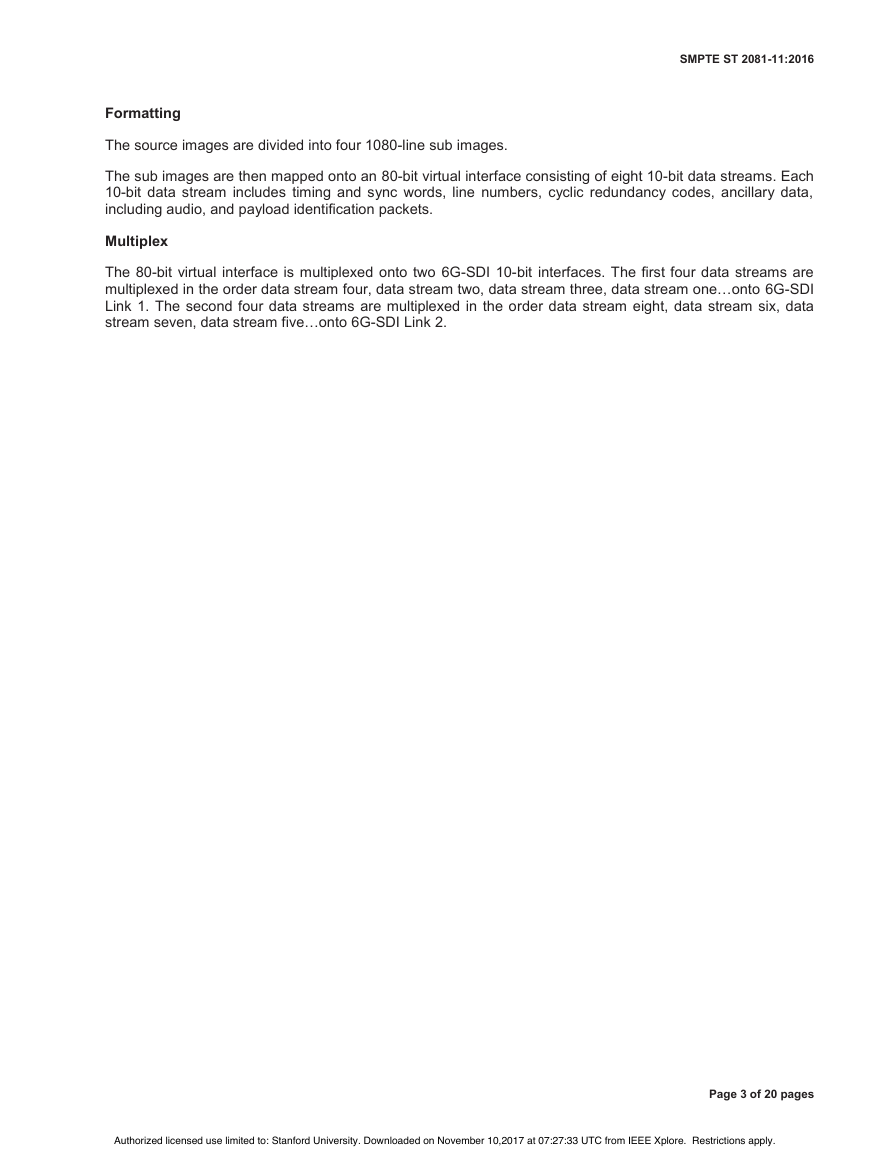

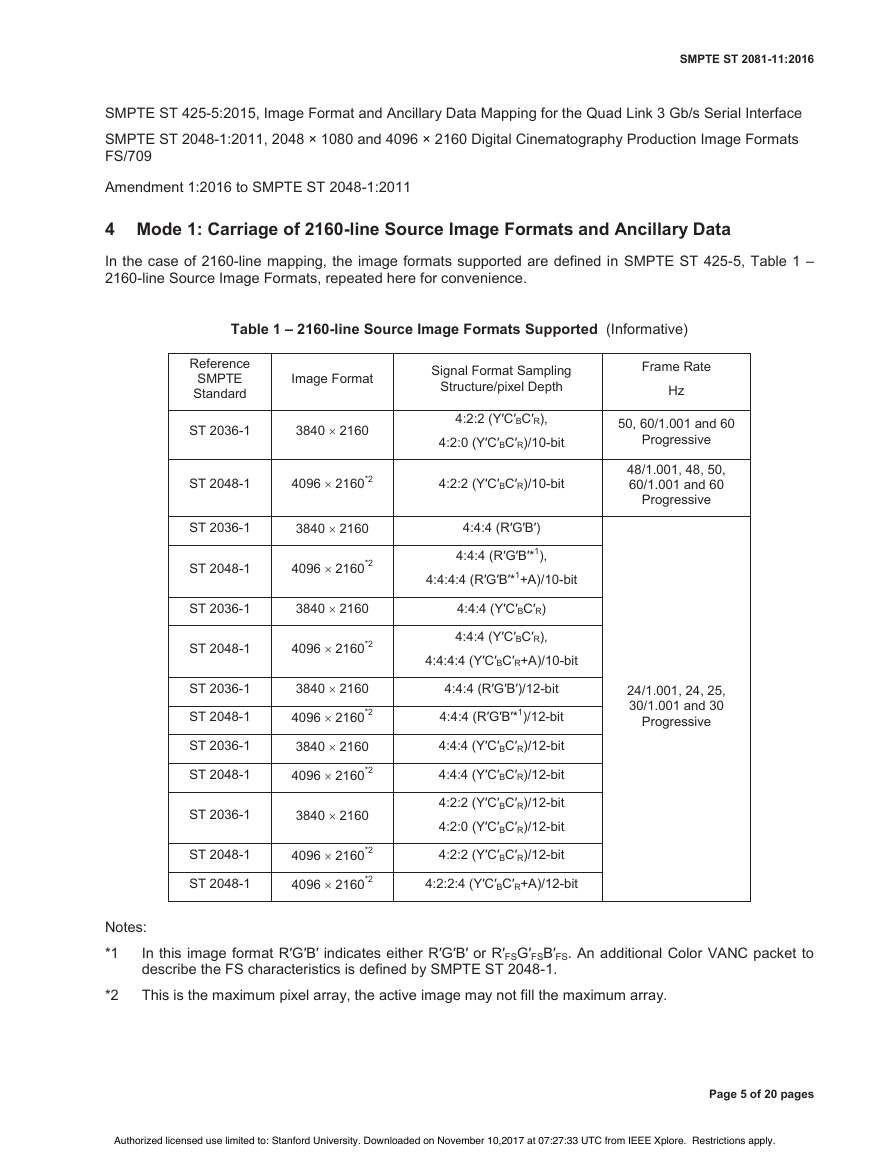
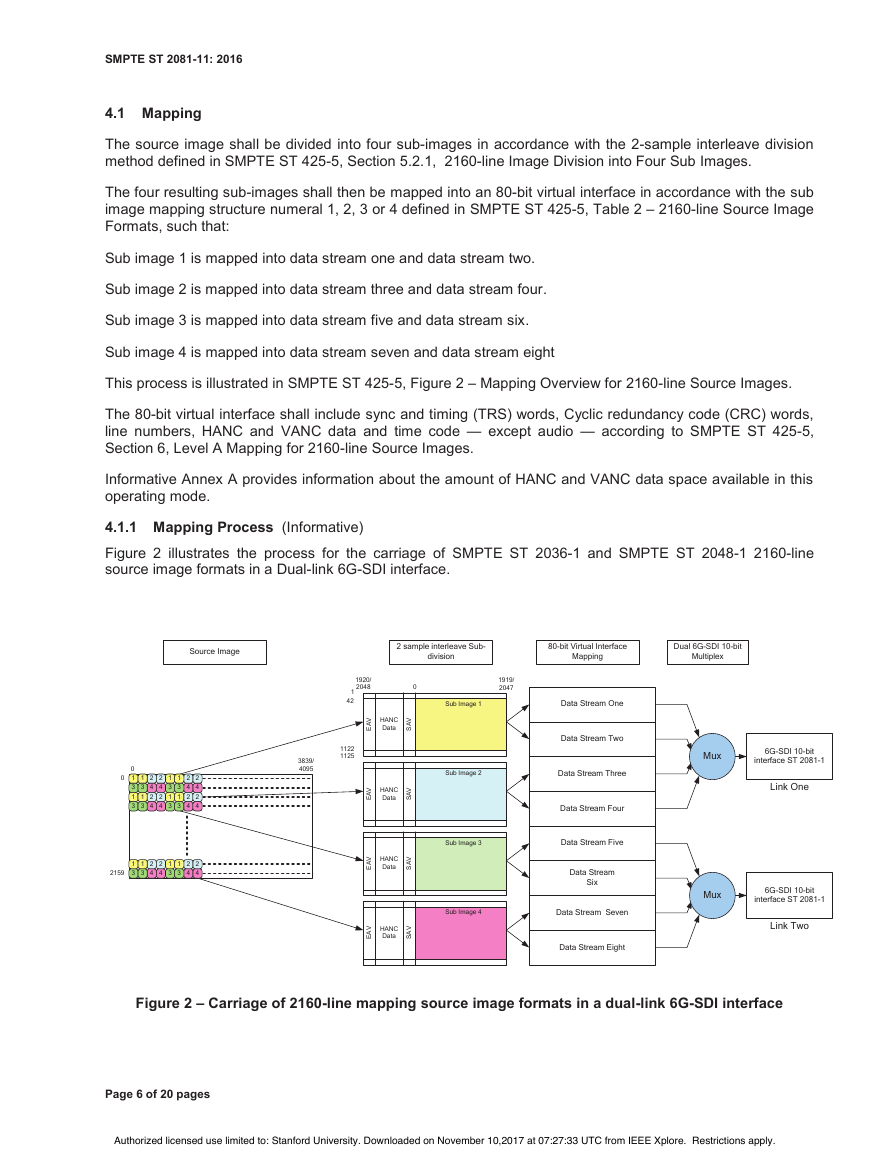
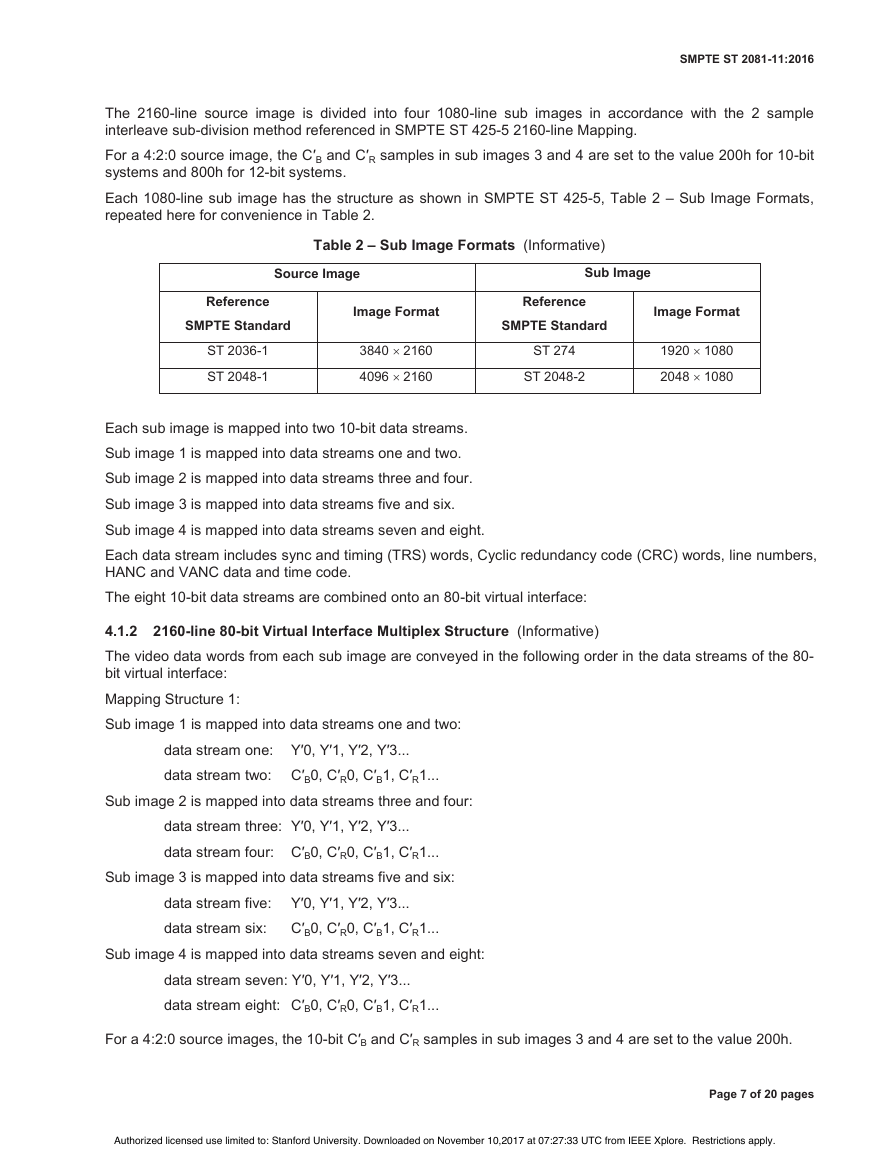
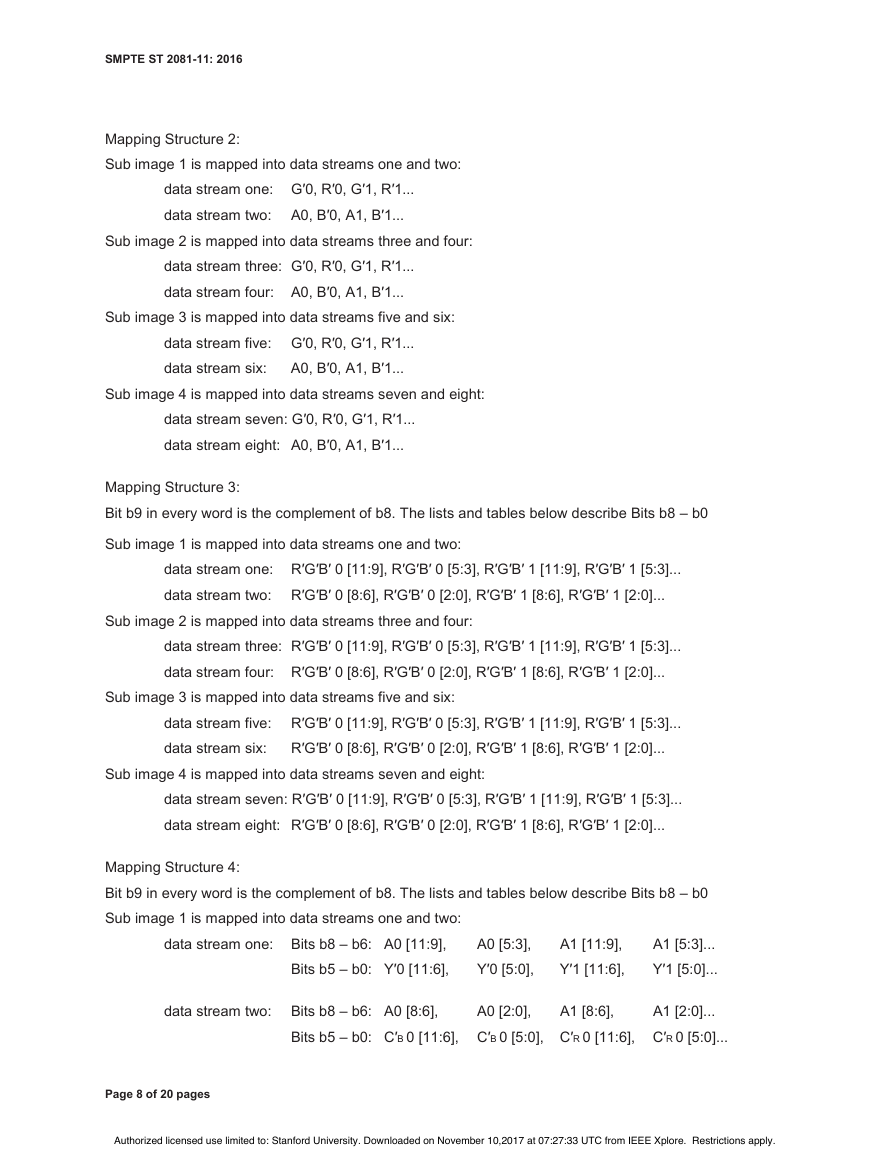








 2023年江西萍乡中考道德与法治真题及答案.doc
2023年江西萍乡中考道德与法治真题及答案.doc 2012年重庆南川中考生物真题及答案.doc
2012年重庆南川中考生物真题及答案.doc 2013年江西师范大学地理学综合及文艺理论基础考研真题.doc
2013年江西师范大学地理学综合及文艺理论基础考研真题.doc 2020年四川甘孜小升初语文真题及答案I卷.doc
2020年四川甘孜小升初语文真题及答案I卷.doc 2020年注册岩土工程师专业基础考试真题及答案.doc
2020年注册岩土工程师专业基础考试真题及答案.doc 2023-2024学年福建省厦门市九年级上学期数学月考试题及答案.doc
2023-2024学年福建省厦门市九年级上学期数学月考试题及答案.doc 2021-2022学年辽宁省沈阳市大东区九年级上学期语文期末试题及答案.doc
2021-2022学年辽宁省沈阳市大东区九年级上学期语文期末试题及答案.doc 2022-2023学年北京东城区初三第一学期物理期末试卷及答案.doc
2022-2023学年北京东城区初三第一学期物理期末试卷及答案.doc 2018上半年江西教师资格初中地理学科知识与教学能力真题及答案.doc
2018上半年江西教师资格初中地理学科知识与教学能力真题及答案.doc 2012年河北国家公务员申论考试真题及答案-省级.doc
2012年河北国家公务员申论考试真题及答案-省级.doc 2020-2021学年江苏省扬州市江都区邵樊片九年级上学期数学第一次质量检测试题及答案.doc
2020-2021学年江苏省扬州市江都区邵樊片九年级上学期数学第一次质量检测试题及答案.doc 2022下半年黑龙江教师资格证中学综合素质真题及答案.doc
2022下半年黑龙江教师资格证中学综合素质真题及答案.doc